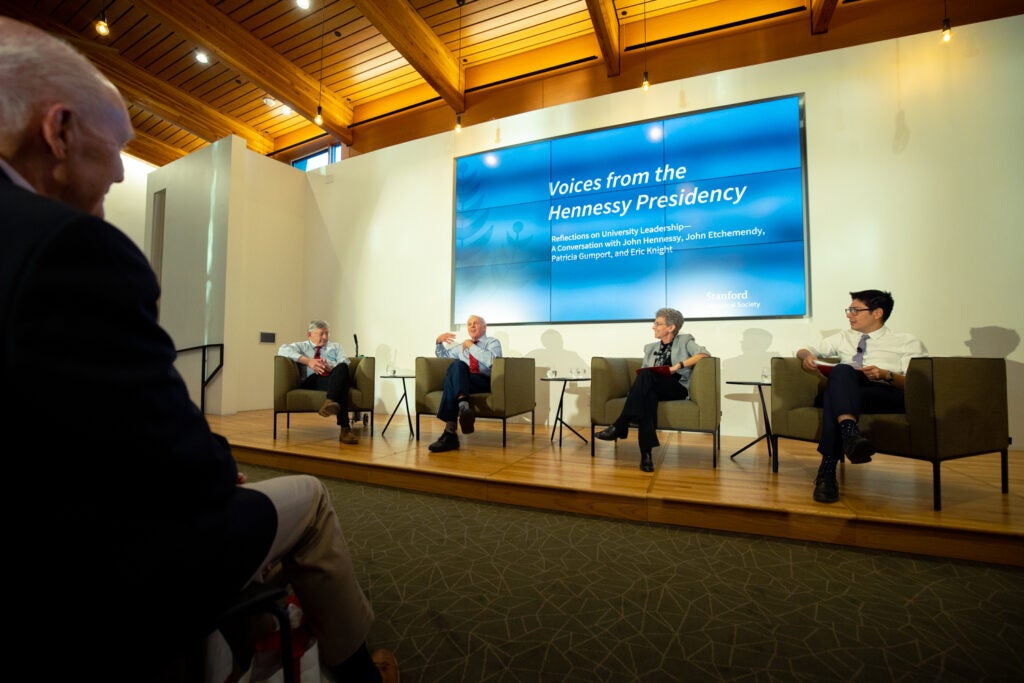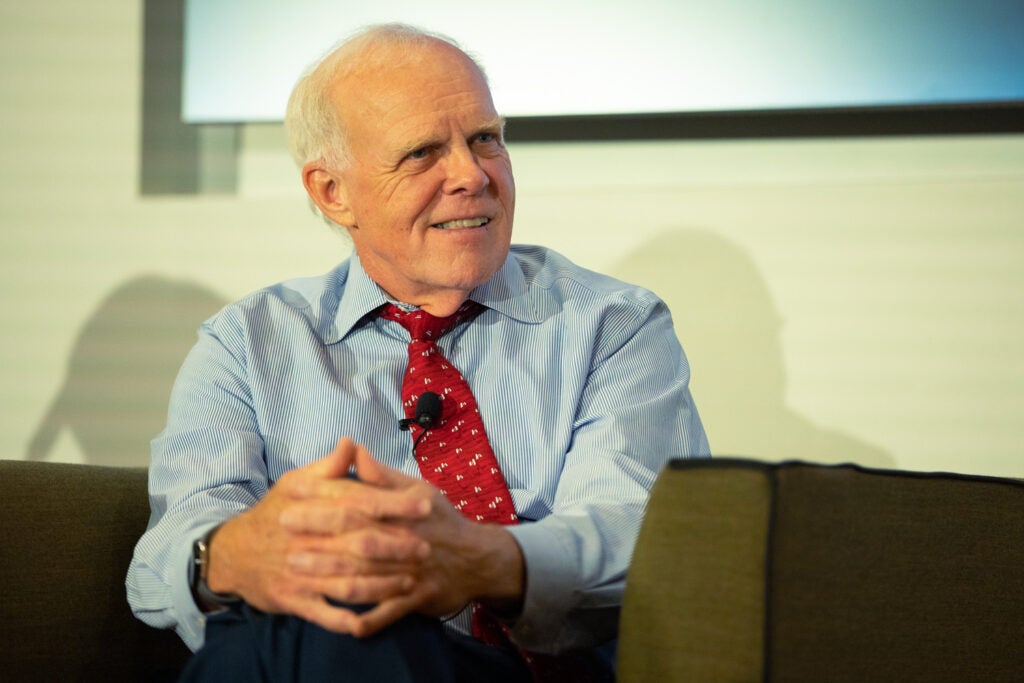Hennessy, Etchemendy look back on 16 years of leadership at Stanford
The Stanford Historical Society hosted an event for former President John Hennessy and former Provost John Etchemendy to reflect on the challenges, strategies, and fond memories from their time in office.
When John Hennessy assumed the Stanford presidency in 2000, he looked to the university’s existing legacy to help create his vision for its future.

John Hennessy and John Etchemendy discuss their administration at Denning House on Tuesday, Feb. 7, 2023. (Image credit: Andrew Brodhead)
“Stanford had a long history of transformative effect in Silicon Valley,” he said during a recent panel discussion hosted by the Stanford Historical Society. “Could we take that culture of making a difference in the world and broaden it to a wider set of fields, thinking creatively about finding new solutions?”
That ethos helped him and his administration through the next 16 years of leadership, which resulted in significant growth and achievement for the university.
The experiences, challenges, strategies, and fond memories of that period were the subject of the discussion, which took place last Tuesday at Denning House before a live audience of about 150 people and another 500 viewing online from around the world.
The event included former Provost John Etchemendy and was co-moderated by Patricia Gumport, professor of education, who served as Stanford’s first vice provost for graduate education during the Hennessy presidency, and Eric Knight, professor of organizational theory and strategic management at Macquarie University in Sydney, Australia. Knight is also the editor of Voices from the Hennessy Presidency: Collected Interviews with University Leaders, 2000-2016 (Stanford Historical Society, 2023), a collection of interviews with 21 leaders in higher education reflecting on their experiences at Stanford under Hennessy’s leadership.
Getting started
The conversation opened with a reflection on the state of the university in the late 1990s, just before Hennessy and Etchemendy took office. They noted that the previous administration, led by President Gerhard Casper and Provost Condoleezza Rice, made significant investments, particularly in undergraduate education. For instance, they encouraged more leading faculty, including Nobel Prize winners, to teach undergraduate courses.

John Hennessy served as Stanford’s 10th president from 2000 to 2016. (Image credit: Andrew Brodhead)
Upon taking office, Hennessy and Etchemendy conducted a university-wide needs assessment. But soon after, they received powerful advice during a Board of Trustees meeting.
“Walter Hewlett raised his hand, and said, ‘You have to stop asking what Stanford needs, you have to ask what the world needs,’ ” Etchemendy recalled. “And that turned our thinking around in quite a significant way.”
The leaders looked beyond Stanford to guide their next steps. Global challenges related to climate change, peace and security, quality of life, and more, would inform the new administration’s approach to leadership.
“We started thinking about, brainstorming, what should be the role of the university in thinking about these big societal issues?” Hennessy said.
Etchemendy agreed and said he viewed Stanford as a national and global resource that must support the common good.
“We are a service organization,” he said. “That is what a university is or ought to be, and it ought to see itself that way – as serving the country.”
They assembled a team of deans, vice provosts, and vice presidents, which served as an academic planning group that conceptualized the path forward for the university.
Growth and transformation
During the Hennessy presidency, Stanford experienced significant growth in its student, postdoc, and faculty populations, as well as in its academic and research activities. Hennessy and Etchemendy said Stanford’s transformation often happened organically. They explained that at universities, new knowledge and fields often develop, requiring additional faculty. For example, the bioengineering department (created during their tenure) was the first at Stanford to sit between two schools: Engineering and Medicine.
“We managed to start a new department, which in 10 years was in the top five or 10 in the country,” Hennessy said. “That was an enormous achievement, which, I have to say, the deans really worked hard to make work.”
Today, Stanford excels at interdisciplinarity, in part because of a large push by Hennessy’s administration to encourage collaboration across all the schools.
“The whole should be greater than the sum of the parts. That was kind of the message we were trying to send,” Hennessy said, adding that every department at Stanford also shared the same focus and dedication to excellence.
Hennessy cited Stanford Bio-X, which was established in 1998, and the new Stanford Doerr School of Sustainability, as two examples of Stanford’s strong culture of collaboration.
Adversity and decision-making
Perhaps the greatest global challenge that occurred during the Hennessy presidency was the 2008 financial crisis. At the time, Silicon Valley was incurring a slowdown, including at Stanford, where the university’s endowment dropped 26 percent in one year.
“The largest drop … in the history of the endowment prior to that was 7 percent,” Etchemendy said. “So that’s a big, big hit on a very important income source.”
Rather than easing into the crisis by implementing small cuts over several years, Hennessy and Etchemendy decided to make larger cuts over just two years. That strategy forced them to make better decisions and avoid prolonging Stanford’s response to the crisis, they said. By quickly and temporarily freezing salaries, raises, and hiring, they “pulled the band-aid off.” The approach worked. Soon after, the university was hiring faculty again while other institutions were still cutting budgets.
“I knew the best way to get through that process was to do it once, do it quickly, get it over with, move forward, [and] get to the light at the end of the tunnel,” Hennessy said.
In the past, Etchemendy has noted that threats to institutions often come from within. When asked to elaborate, he explained his concern about the increasing homogenization of viewpoints at Stanford, both in terms of political views and within disciplines.
“We tend to find the accepted narrative – what is the party line on this particular issue in this particular field? – and everybody that you hire is thinking the same thing,” he said. “[But] that is anathema to what a university is supposed to be. I was worried that we were getting more and more narrow and more and more one-sided.”
When Gumport asked how free expression fits with Stanford’s commitment to inclusion, Etchemendy made clear that he believes free expression and open debate are “absolutely essential” to what the university is and how it functions, and thus takes priority.
“Of course, we want to be an inclusive community,” he said. “But we can’t not have open debate simply because we think we’re going to hurt people’s feelings.”
He said the university has a responsibility to teach students how to accept disagreement and recover from offense.
“We need to teach students resilience,” he said.
Memorable moments
When asked about their favorite memories during their tenure, Hennessy cited the Nobel Prize wins, conducting the Stanford Band, traveling the country and world to visit alumni, hearing Steve Jobs deliver “the best commencement speech ever” in 2005, and witnessing the growth of students during their time at Stanford.
“From the Opening Convocation, being there with the students in the Quad when we do Convocation and getting to meet them and their families, to graduation – it was a marvelous experience,” he said.
Hennessy also noted the importance of Stanford’s alumni, who serve as envoys for the knowledge they acquire at Stanford.
“Universities have this remarkable property [in] that every year, a large number of people get up and leave, and they take all that knowledge and insight, and bring it out into the world and help do wonderful things with it,” he said.